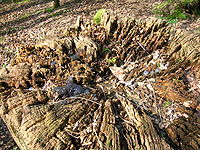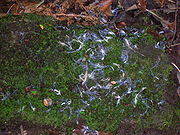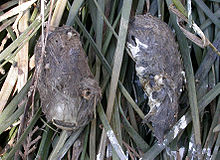
Plucking post
Encyclopedia
A plucking post is a raised structure such as a tree stump which is used regularly by a bird of prey
to dismember its prey, removing feathers and various other inedible parts before eating it.

 The elevated nature of the post allows for a safer landing with the heavy load of the prey, as well as being a good vantage point to scan for other predators, while the bird is vulnerable, involved in the relatively complex process of plucking and feeding upon its prey. Many owls use plucking posts for prey that has been caught on the ground. Barred Owl
The elevated nature of the post allows for a safer landing with the heavy load of the prey, as well as being a good vantage point to scan for other predators, while the bird is vulnerable, involved in the relatively complex process of plucking and feeding upon its prey. Many owls use plucking posts for prey that has been caught on the ground. Barred Owl
s often use old nests for the purpose. Plucking posts are used by Barn Owl
s which hunt by flying low and slowly over an area of open ground, hovering over spots that conceal potential prey. The Barn Owl feeds primarily on small vertebrates, particularly rodents. The Common Buzzard
is another user of plucking posts and has an even more varied diet than the Barn Owl. The Sparrowhawk
flies low over the ground, skimming hedges and fences, but staying close to cover so that it can rapidly pounce on its victims. In woodland its agility enables it to fly swiftly between the trunks and branches.
In New Zealand the New Zealand Falcon takes its catch to a plucking post to dislocate the bird's neck using the notch on its bill
that all falcons have. It then plucks the feathers before eating the entire bird.
Plucking posts are ideal places for setting up bird hide
s, thus allowing a close observation of bird of prey feeding behaviour.

 The post provides a firm surface for an effective grip by the bird's talons and sometimes crevices for helping with the mechanical separation of the prey. Natural tree stumps and man-made structures such as straining and fence posts. Boulders may be used, especially if they have a carpet covering of moss or are cracked or ribbed.
The post provides a firm surface for an effective grip by the bird's talons and sometimes crevices for helping with the mechanical separation of the prey. Natural tree stumps and man-made structures such as straining and fence posts. Boulders may be used, especially if they have a carpet covering of moss or are cracked or ribbed.
Bird pellets
are often found on or around plucking posts, composed of the indigestible items that were consumed by the predator.
Plucking posts, surrounded by feathers and fur, may indicate that a raptor nesting site is nearby and these may be mainly used during the breeding season.
Scientists can use the evidence of plucking posts to provide information about the feeding behaviour of relevant raptors.
It has also been suggested that faeces marks and plucking may represent a widespread method for communicating current reproduction and territory to conspecifics.
In secure or difficult surroundings the plucking post may be at ground level.
Bird of prey
Birds of prey are birds that hunt for food primarily on the wing, using their keen senses, especially vision. They are defined as birds that primarily hunt vertebrates, including other birds. Their talons and beaks tend to be relatively large, powerful and adapted for tearing and/or piercing flesh....
to dismember its prey, removing feathers and various other inedible parts before eating it.
Purpose


Barred Owl
The Barred Owl is a large typical owl. It goes by many other names, including eight hooter, rain owl, wood owl, and striped owl, but is probably best known as the hoot owl.-Description:...
s often use old nests for the purpose. Plucking posts are used by Barn Owl
Barn Owl
The Barn Owl is the most widely distributed species of owl, and one of the most widespread of all birds. It is also referred to as Common Barn Owl, to distinguish it from other species in the barn-owl family Tytonidae. These form one of two main lineages of living owls, the other being the typical...
s which hunt by flying low and slowly over an area of open ground, hovering over spots that conceal potential prey. The Barn Owl feeds primarily on small vertebrates, particularly rodents. The Common Buzzard
Common Buzzard
The Common Buzzard is a medium to large bird of prey, whose range covers most of Europe and extends into Asia. It is usually resident all year, except in the coldest parts of its range, and in the case of one subspecies.-Description:...
is another user of plucking posts and has an even more varied diet than the Barn Owl. The Sparrowhawk
Sparrowhawk
The Eurasian Sparrowhawk is a small bird of prey in the family Accipitridae. Adult male Eurasian Sparrowhawks have bluish grey upperparts and orange-barred underparts; females and juveniles are brown above with brown barring below...
flies low over the ground, skimming hedges and fences, but staying close to cover so that it can rapidly pounce on its victims. In woodland its agility enables it to fly swiftly between the trunks and branches.
In New Zealand the New Zealand Falcon takes its catch to a plucking post to dislocate the bird's neck using the notch on its bill
Beak
The beak, bill or rostrum is an external anatomical structure of birds which is used for eating and for grooming, manipulating objects, killing prey, fighting, probing for food, courtship and feeding young...
that all falcons have. It then plucks the feathers before eating the entire bird.
Plucking posts are ideal places for setting up bird hide
Bird hide
A bird hide is a shelter, often camouflaged, that is used to observe wildlife, especially birds, at close quarters. Although hides were once built chiefly as hunting aids, they are now commonly found in parks and wetlands for the use of bird watchers, ornithologists and other observers who do not...
s, thus allowing a close observation of bird of prey feeding behaviour.
Function


Bird pellets
Pellet (ornithology)
A pellet, in ornithology, is the mass of undigested parts of a bird's food that some bird species occasionally regurgitate. The contents of a bird's pellet depend on its diet, but can include the exoskeletons of insects, indigestible plant matter, bones, fur, feathers, bills, claws, and teeth...
are often found on or around plucking posts, composed of the indigestible items that were consumed by the predator.
Plucking posts, surrounded by feathers and fur, may indicate that a raptor nesting site is nearby and these may be mainly used during the breeding season.
Scientists can use the evidence of plucking posts to provide information about the feeding behaviour of relevant raptors.
It has also been suggested that faeces marks and plucking may represent a widespread method for communicating current reproduction and territory to conspecifics.
In secure or difficult surroundings the plucking post may be at ground level.

